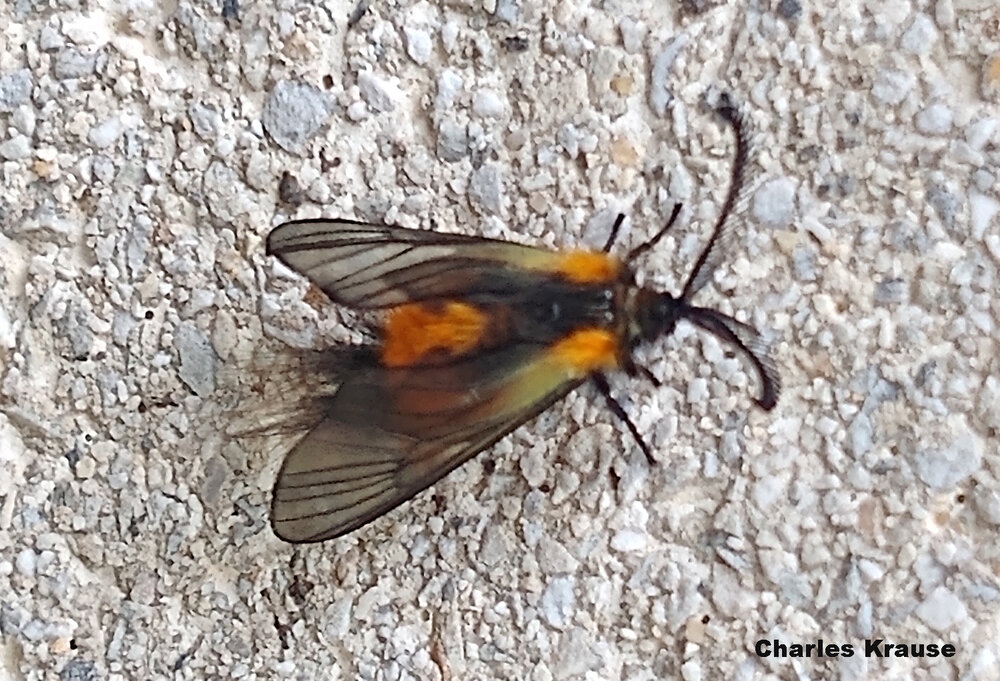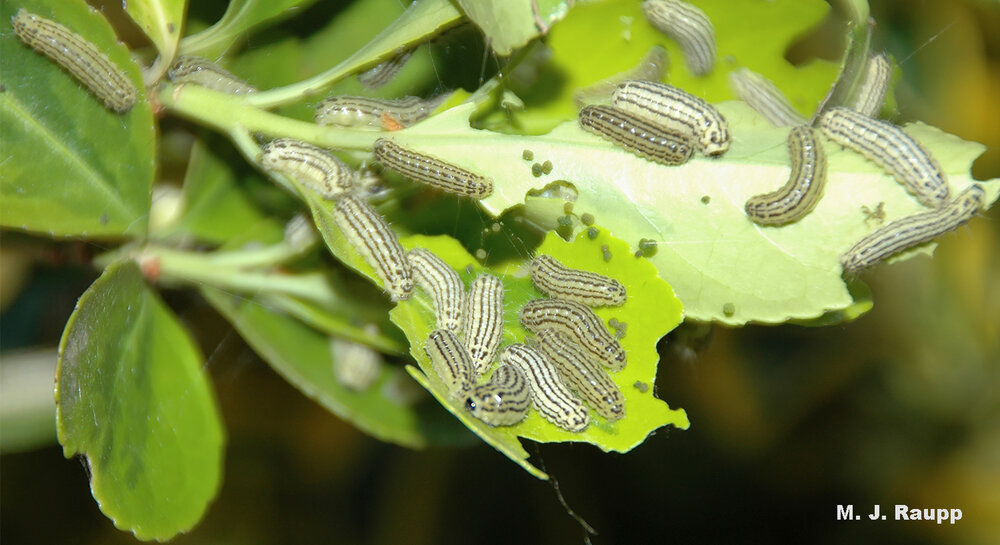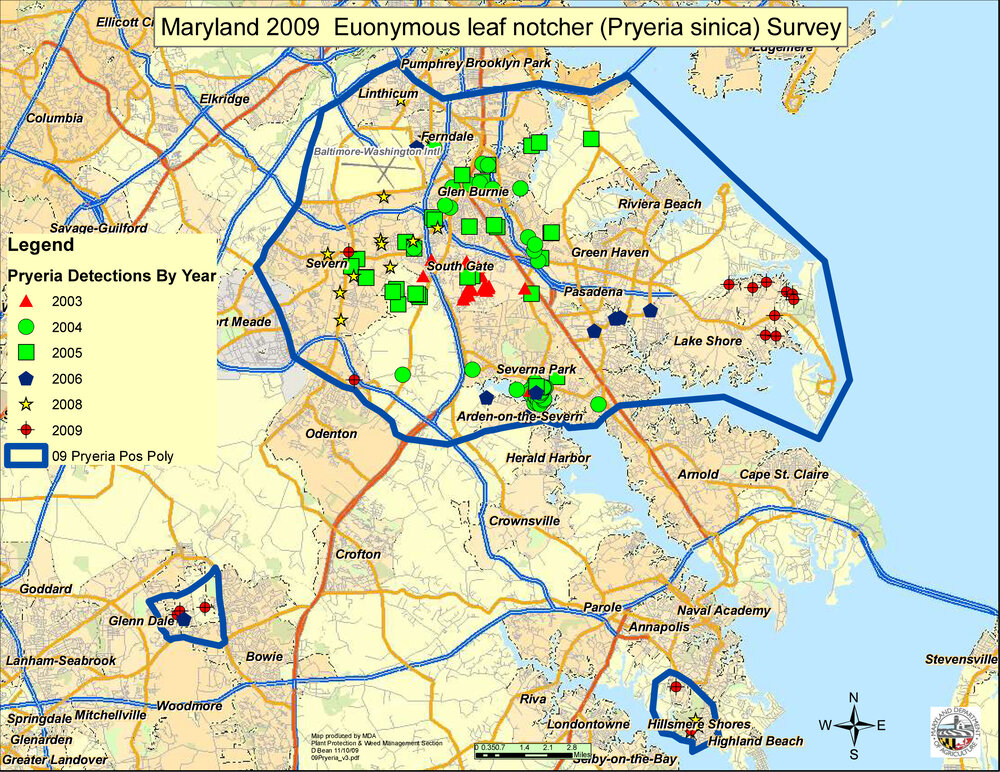Look out Pennsylvania, an invasive pest is headed your way: Euonymus leaf- notcher, Pryeria sinica

Adult euonymus leaf-notcher moths fly in autumn and mimic wasps. This one was found less than 10 miles from the Pennsylvania boarder in Hampstead, Maryland. Photo credit: Charles Krause
Followers of Bug of the Week have witnessed the tale of spotted lanternfly unfold from its first discovery in Berks County, PA in 2014 to its spread across states lines, including Maryland’s border in 2018. With a recent sighting of euonymus leaf-notcher adults in Hampstead, MD less than 10 miles from the PA border, it looks like some of Maryland’s troubles may be heading Pennsylvania’s way. Let’s review how we got here. Back in 2002 a new pest was discovered in Fairfax, VA when a homeowner noticed a voracious caterpillar munching her ornamental euonymus. The caterpillars were sent to Eric Day at the Insect Identification Laboratory in Blacksburg, VA. Eric reared the larvae and sent the unknown moths to specialist John Brown at the Systematic Entomology Laboratory, USDA. Dr. Brown identified the moth as one not known to occur in the US – a new, exotic, invader. The scientific name of this alien is Pryeria sinica. Prior to its discovery in Fairfax, this pest was only known from eastern Russia and China through Korea, Japan, and Taiwan.

Hordes of caterpillars strip leaves and create frass fouled foliage (repeat three times fast).
In 2003 more moths were collected in Northern Virginia and on May 28, 2003 Gaye Williams at the Maryland Department of Agriculture identified specimens of Pryeria sinica from Anne Arundel County, Maryland. Somewhere along the way the new pest was dubbed the euonymus leaf-notcher due to the distinctive pattern of feeding caused by the caterpillar. As the large caterpillars eat, sections of leaf along the margin disappear down their gullets, hence the name leaf-notcher. The leaf-notcher passes winter as taupe colored eggs deposited in clusters of 150 or more on pencil-sized twigs near terminals of branches. Eggs hatch in mid-March and early April, and tiny caterpillars first feed in tight silken webs spun around unfolded leaves at terminals. As larvae grow, they move to expanded leaves to feed and are often found in large groups. Their presence is easily recognized by marginal notches and coarsely shredded leaves on the ground below. When abundant, these caterpillars can entirely strip shrubs.
After completing development in early summer, larvae wander from the plants seeking protected locations to pupate. Large numbers of wandering caterpillars may alarm homeowners, but citizens should remain calm as caterpillars are not known to eat humans or pets. Caterpillars spin pupal cocoons amidst fallen leaves and adult moths appear in the autumn to fly, mate, and lay eggs on the terminals of euonymus branches. Unlike many moths, these are day fliers. They have unique patterns and colors on their body and wings that make them closely resemble wasps. The fact that they mimic wasps may help them avoid being eaten by day feeding predators such as birds. In North America, the leaf-notcher has been reported on Euonymus japonicus and E. kiautschovicus ‘Manhattan’. In its native range in Asia, the pest has been reported feeding on E. sieboldianus, E. japonicus, and E. alatus. Moreover, other members of the Celastraceae such as Celastrus punctatus and C. orbiculatus are recorded as hosts for this pest.
In early spring, euonymus leaf-notchers hatched from eggs and scores of caterpillars began to strip leaves of euonymus. After completing development in spring, caterpillars spun silken cocoons in protected locations. In late October and November, adult moths emerged from very cute pupae, mated, and deposited overwintering eggs on twigs of euonymus.
The pest has two obvious weak points that provide excellent opportunities for management. From the time that egg laying ends in December until eggs hatch in spring, eggs can be crushed on the plant or simply removed by pruning off the terminal and disposing of it. If larvae are small or in restricted areas on a plant, then they too may be removed by a gloved hand or pruner. If larvae are widely distributed, abundant, or otherwise difficult to control manually, then several insecticides should perform well. Some of the most “environmentally friendly” insecticides for killing caterpillars contain Bacillus thuringiensis kurstaki (Btk) or the active ingredient called spinosad. Btk destroys cells in the gut of the caterpillar, a slow and painful death to be sure. Spinosad acts on the nervous system of the caterpillar, inducing a more rapid, twitchy form of death.

In 2009, surveys conducted by the Maryland Department of Agriculture discovered euonymus leaf-notcher in Anne Arundel and Prince Georges Counties in Maryland. Image credit: Maryland Department of Agriculture
Euonymus leaf notcher, where are you now? While no formal records are being kept at the present time by most state agencies, if you think you have spotted this pest you are always welcome to send an image to Bug of the Week care of Mike Raupp at [email protected]. Of course, you can also contact your state Department of Agriculture or University Extension Service and give them a heads-up. Happy leaf-notcher hunting!
Acknowledgements
Many thanks to Charles Krause for sharing his wonderful images of euonymus leaf-notcher and providing the inspiration for this episode. Thanks also to Gaye Williams of the Maryland Department of Agriculture for confirming the identity of the adult moth.
This post appeared first on Bug of the Week